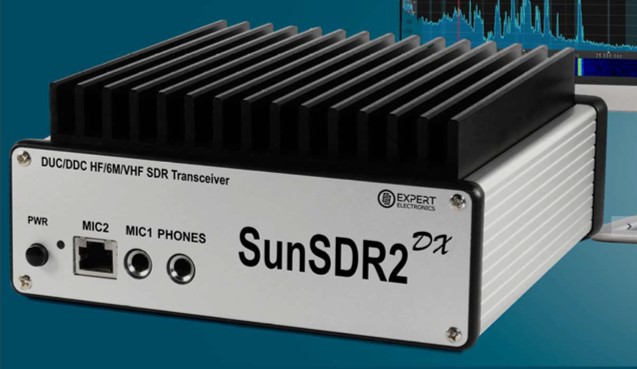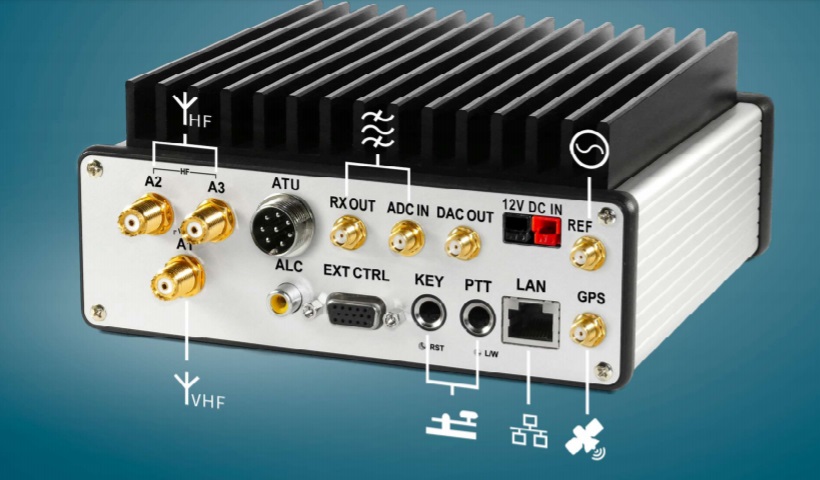News Archive
New SunSDR2 DX !!!
 | SunSDR2 DX DIRECT SAMPLING HF/6M/VHF 100W TRANSCEIVER |
The SunSDR2 DX transceiver based on the well known SunSR2 PRO transceiver with several hardware impovements. A 100W HF, 50W 6M, 8W VHF transceiver, very compact, with a separate connector for active cooling and an improved supply system, perfectly suited for DXpeditions. Separated GPS/GLONASS antenna and ATU connectors. improved hardware along with the ExpertSDR2 software makes it the perfect base station, an evident choice for a true contester! Hardware Improvements
Feautures
Available September - November |
Erste FTDX101D ab 3. mai 2019 !!!!!!!!!
Spezielle Offerte 3699.- CHF
EXPERT ELECTRONICS: ExpertSDR2 1.3.0 Beta 1
Hello, everyone!
Here is the April newsletter
Today we've published the ExpertSDR2 1.3.0 Beta 1 for all our devices. All changes are mentioned in the Release Notes, as always. We thank everyone who shared his opinion about new software.
The purpose of ALPHA/BETA/RC versions of the software is to collect user's feedback on the new features and to locate possible issues which could be missed while internal testing. These versions may have bugs, which will be fixed in further software releases.
We'd like to welcome you to the Hamvention 2019, it will be held May 17, 18 and 19, at the Greene County Fairgrounds and Expo Center. You can find us in the Building 4 Volta, booths 4211-4212.
We are happy to inform macOS users, that from now on MacLoggerDX supports TCI. Quote from MacLoggerDX developer Don Agro, VE3VRW, regarding the published beta with TCI support: "Preliminary testing has been done on all radios but it is still a beta - if you run into problems please enable Debug Log in the Radio prefs, attempt to connect and then Email Debug Log from the File menu including a screen-shot of your Radio prefs".
Last March Enzo, IW7DMH, made a very interesting, short video where you can see two different ways to setup a basic SO2R contest station.
In a previous newsletter I shared a couple of educational videos about SDR by David Kennett, W8KFJ. Since then he released the third and final one.
SDR School Part 3 Software Puts it all Together
We'd like to thank Werner Schnorrenberg, DC4KU, for his detailed report about the three ways how to work with the ColibriNANO, on English and German:
- connect it via USB with the Notebook/PC (Standard)
- connect it via Raspberry and LAN/WLAN with the Notebook or Smartphone/Tablet in your home network
- connect it via Raspberry to the internet (www)
English German
Those who are interested to be an alpha/beta tester please let me know, I can send you the download link as soon as any preview/alpha/beta/RC version (BE AWARE IT'S MOST PROBABLY BUGGY) will be available.
We created a new page Bug report for the Alpha/Beta/RC to help us synchronize your feedback for the published Alpha/Beta/RC versions of the ExpertSDR2. On this page we'll list all known and reported bugs for the latest published software version.
Expert Electronics
Three ways how to work with the ColibriNANO
New YAESU FTDX101 Catalogue
WIRES-X Portable Digital Node Station
Using the WIRES-X Portable Digital Node function, you can operate a WIRES-X digital node station by directly connecting a Portable Digital Node capable C4FM digital transceiver with the PC. The HRI-200 Internet interface kit is not needed, and no fixed or dynamic global IP address is required.)
WIRES-X Portable Digital node function
There are two operating modes of the WIRES-X Portable Digital Node function:
Portable Digital Node Mode
capable of Internet communication only with C4FM digital nodes and rooms.
Portable HRI Mode
capable of Internet communication with both C4FM Digital and Analog nodes and rooms.
1.Portable Digital Node Mode (Supports Internet communication only in C4FM Digital Mode)
Requires a Yaesu C4FM Portable Digital Node capable transceiver (FT2D, FTM-100D, FTM-400XD: as of 2/2019 or Firmware update, FTM-400D: Requires Firmware update) a USB Connection Cable and a PC with WIRES-X Software and Internet connection. Two forms of WIRES-X Access are supported, “Access Point Operation” and “Direct Operation”.
In “Access Point Operation” the Portable Node station can be used to communicate “On Air” and relay nearby local C4FM digital transceivers, while simultaneously connected with the Internet WIRES-X digital rooms and digital node stations.
In “Direct Operation”, the Portable Node station transceiver is used only for WIRES-X internet communications without transmitting or receiving local “On Air” radio signals.
・Access Point Operation
In this mode, WIRES-X C4FM communications are made by either directly using the USB connected Portable Digital Node Station transceiver PTT, microphone, and speaker, or via another local C4FM transceiver communicating on frequency with the USB connected Portable Digital Node Station. The Portable Digital Node Station transceiver connects directly to the PC and the internet, and then communicates with WIRES-X Nodes and Rooms.
The Portable Digital Node Station transceiver relays the local C4FM stations and signals to the internet and transmits the internet Node and Room signals to the local stations. This mode allows the flexibility to operate the Portable Digital Node directly from a single USB connected Digital Node Station transceiver, or to access WIRES-X Nodes and Rooms from one or several local C4FM transceivers.
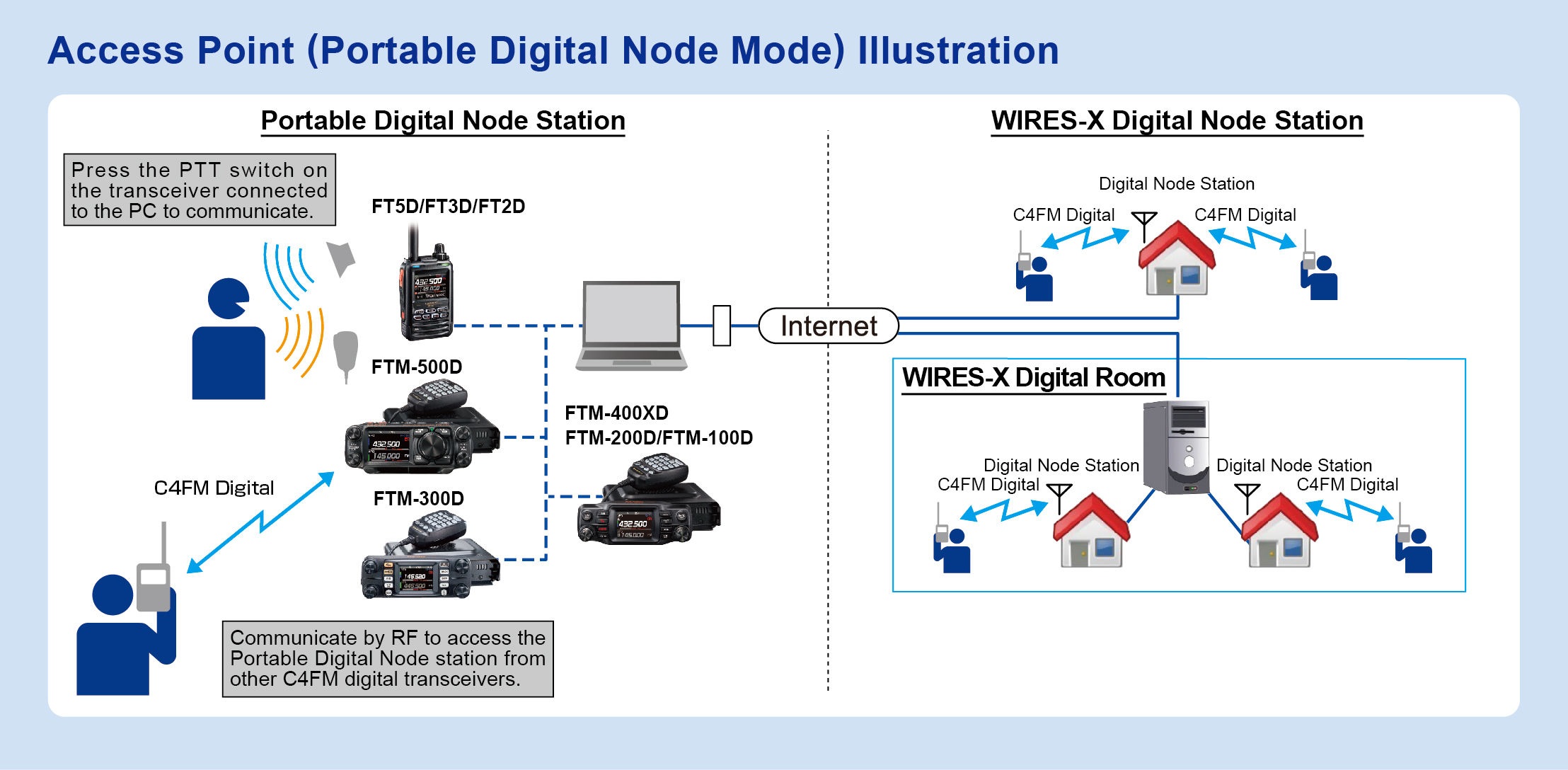
・Direct Operation
In this mode, WIRES-X C4FM communications are made directly by using the USB connected Portable Digital Transceiver Node Station. The microphone signal is sent only to the PC and the Internet. The Internet signals are heard only in the Portable Digital Node Station speaker.
In this Direct Operation, the Portable Digital Node Station transceiver does not transmit or receive over the air.
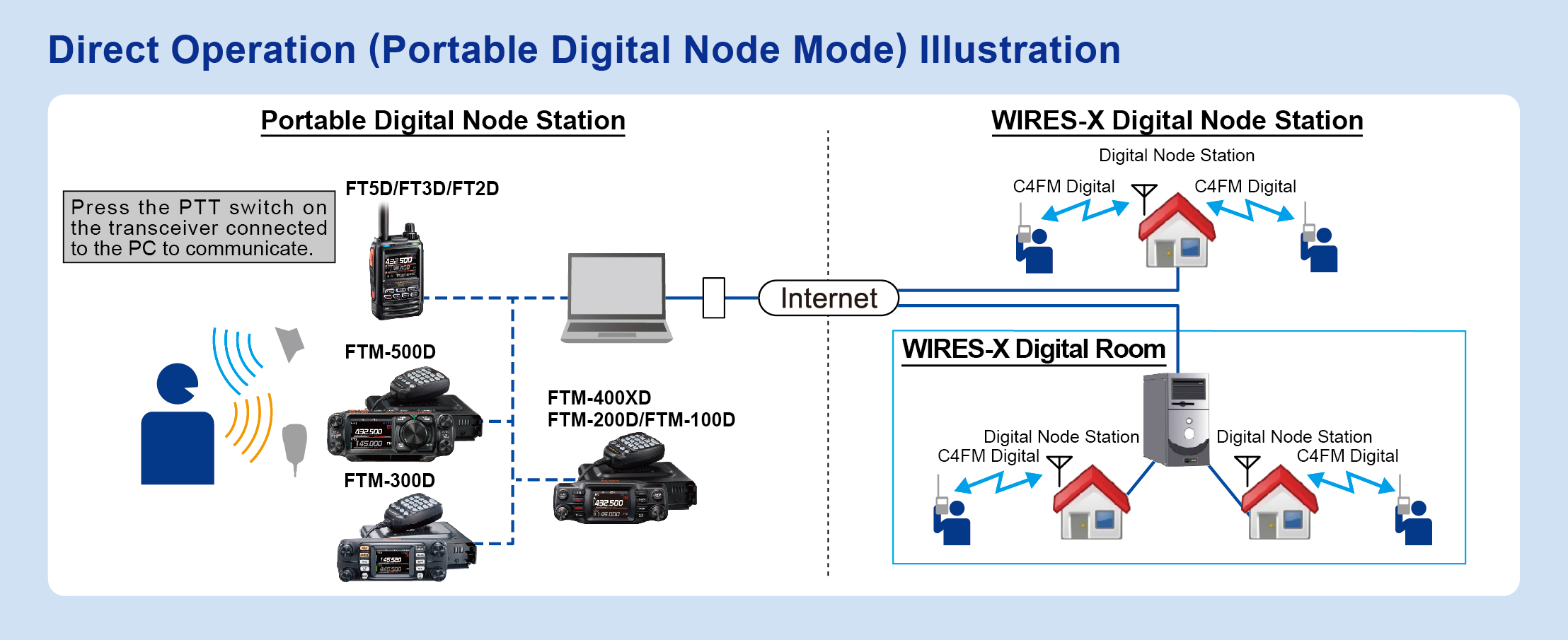
2. Portable HRI Mode(Supports Internet communication in both C4FM Digital Mode and Analog Mode)
Requires a Yaesu C4FM Portable Digital Node capable transceiver, a USB Connection Cable, audio cable and a PC with WIRES-X Software and Internet connection. (The HRI-200 interface is not used)
In the Portable HRI Mode configuration, either the Access Point operation or the Direct operation may be activated:
・Access Point Operation (Portable HRI mode)
In this mode, WIRES-X C4FM and Analog communications are made via another local C4FM transceiver communicating on frequency with the USB connected Portable Digital Node Station.
The Portable Digital Node Station transceiver relays the local C4FM and Analog signals to the internet and transmits the internet Node and Room signals to the local stations. This Access Point operation allows the flexibility to operate the Portable Digital Node to access WIRES-X Nodes and Rooms from one or several local C4FM transceivers.
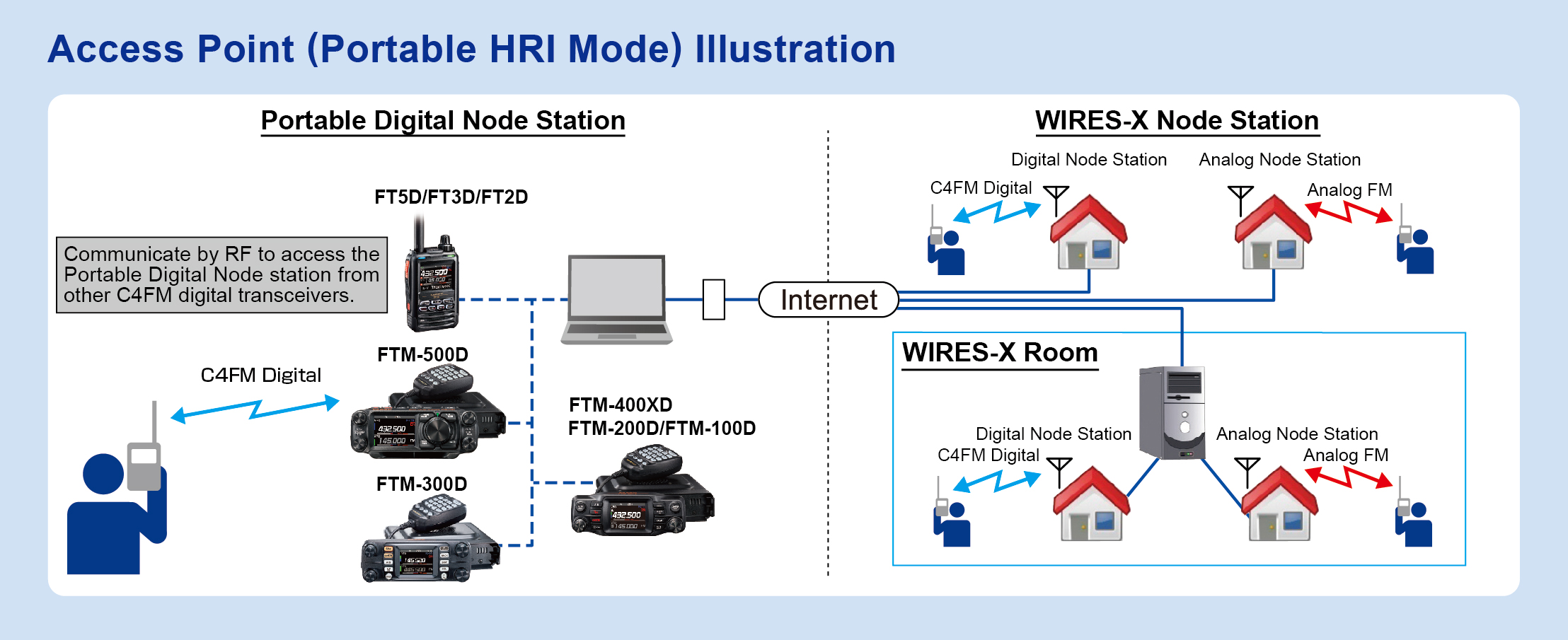
・Direct Operation (Portable HRI mode)
In this mode, you can communicate in digital mode or analog mode via the Internet.
WIRES-X communications are made directly by using the USB connected Portable Digital Node Station Transceiver.
The microphone signal is sent only to the PC and the Internet. The Internet signals are heard in the Portable Digital Node Station transceiver speaker. (when communicating in “Direct Operation” on “Portable HRI mode” using FT2D, the Internet signals are heard only from the PC speaker.) In this Direct Operation, the Portable Digital Node Station transceiver does not transmit or receive over the air.
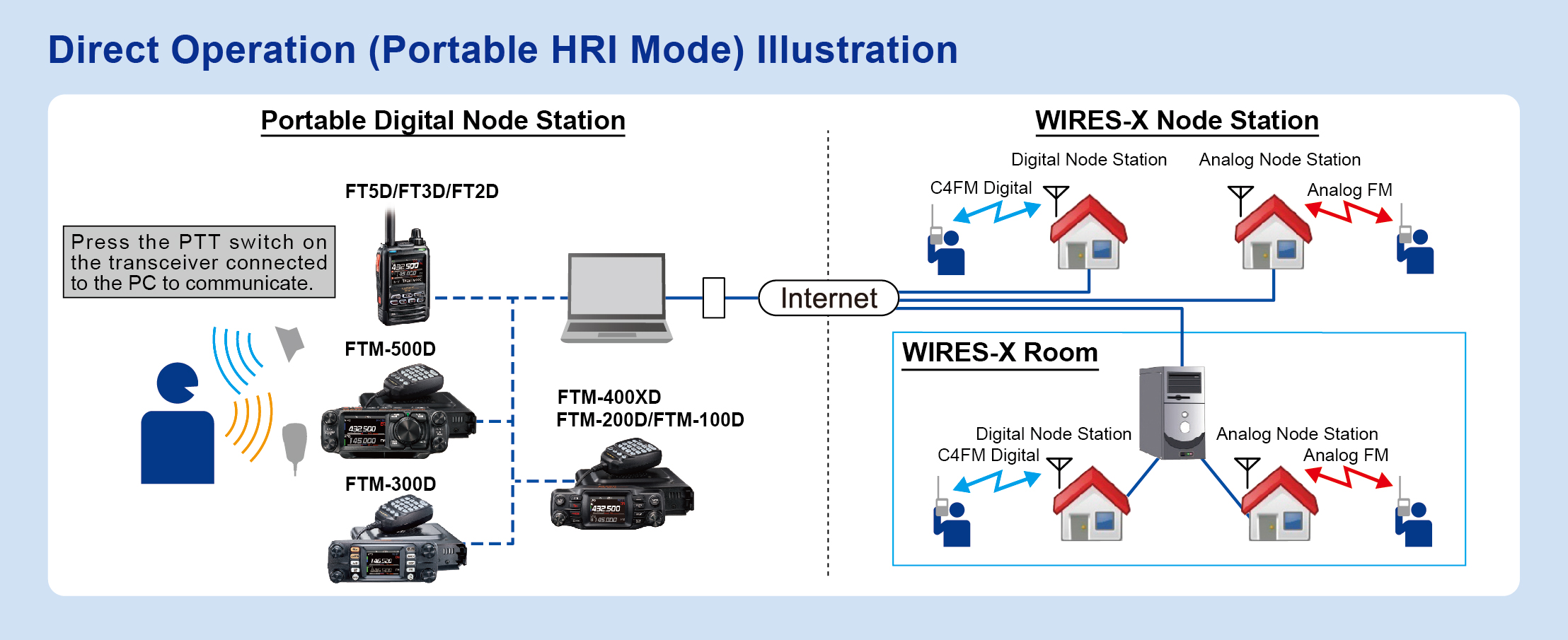
* With the WIRES-X Portable Digital Node function, you cannot operate a WIRES-X Room (Including a digital room) or use the remote-control function from the outside.
WIRES-X Portable Digital Node Function Instruction Manual
(Click here to download the Manual)
User registration (Obtain an ID number)
Please register the WIRES-X ID for the Portable digital node station
Here is the link for the WIRES-X registration:
https://www.yaesu.com/jp/en/wires-x/index.php
Transceivers supported for Portable digital node station operation
(As of Feb. 2019)
• FT2D (or Firmware update)
• FTM-100D (or Firmware update)
• FTM-400XD (or Firmware update)
• FTM-400D (Requires Firmware update)
The latest WIRES-X Software and Transceiver Firmware
• WIRES-X Software: Ver.1.510 or later
• FT2D MAIN: Ver.3.10 or later, SUB: Ver.2.01 or later, DSP: Ver.4.31 or later
• FTM-100D MAIN: Ver.2.40 or later, PANEL: Ver.2.10 or later, DSP: Ver.4.31 or later
• FTM-400XD MAIN: Ver.4.40 or later, DSP: Ver.4.31 or later
• FTM-400D MAIN: Ver.3.40 or later, DSP: Ver.4.31 or later
Update to the latest software and firmware on YAESU website.
Personal Computer
• OS Microsoft® Windows® 7 / 8.1 / 10
• Processor Clock Frequency: 2.0 GHz or faster
• HDD: 1 GB or more of available space
• RAM: 2 GB or more
• Display resolution: 1366 x 768 16-bit high color or higher (32-bit true color is recommended)
• USB port: USB 2.0 (Full-speed USB)
• LAN port:100BASE-TX/1000BASE-T or Wi-Fi: IEEE 802.11 b or higher
• Audio Interfaces*1
*1 Sound function is also required when using the “Portable Digital Node mode” or “Portable HRI mode”. Furthermore, when communicating in “Direct Operation” in “Portable HRI mode” using the FT2D, the personal computer must have the “audio input from the microphone terminal pass to the speaker output” function.
• 3.5 Φ speaker terminal, 3.5 Φ microphone terminal.*2
(It is necessary only for Internet communication in “Portable HRI mode”.)
*2 In the case of a unique terminal such as a laptop, adapt it to a 3.5 Φ speaker terminal and 3.5 Φ microphone terminal with a commercially available conversion cable.
• Speaker (It is necessary only when communicating in Direct Operation using FT2D in “Portable HRI mode”.)
Internet Connection
• ADSL 8 Mbps or faster (high-speed connection recommended)
Connection Cable
Depending on the transceiver used for the portable digital node station, one of the following connecting cables is required:
FT2D:
• SCU-39 WIRES-X Connection Cable Kit (Option)
(The SCU-39 includes SCU-19 and CT-44, and two audio cables)
FTM-100D, FTM-400XD/D:
For Portable Digital Node Mode (Internet communication with C4FM digital stations)
• SCU-20 PC Connection Cable (Supplied with FTM-100D or FTM-400XD/D)
For Portable HRI Mode (Internet communication with both C4FM Digital and Analog Stations)
• SCU-40 Connection Cable (Option)
(The SCU-40 includes SCU-20 and audio cable)

